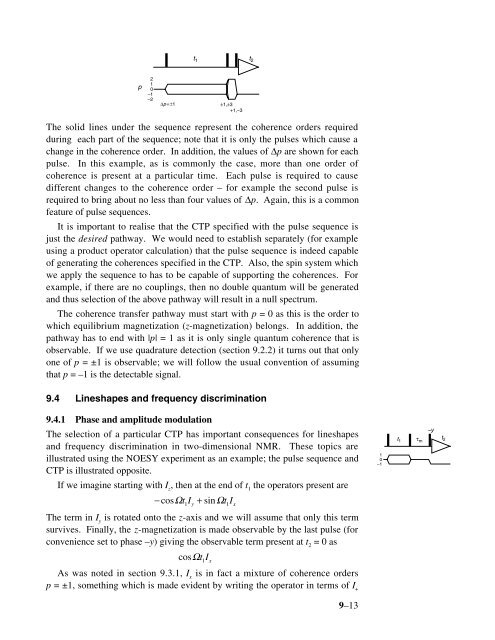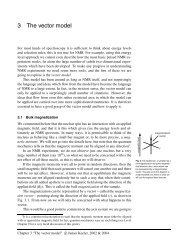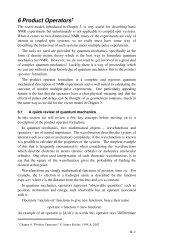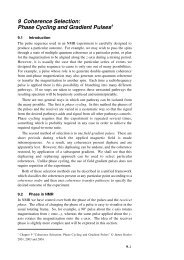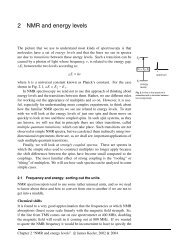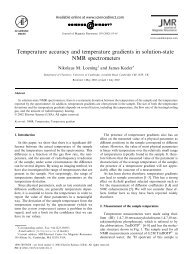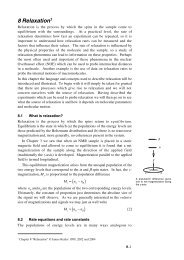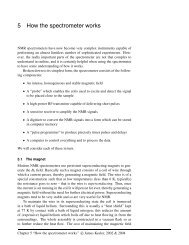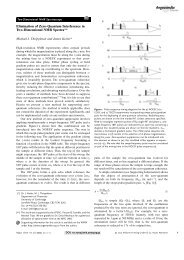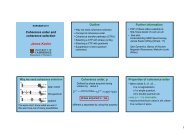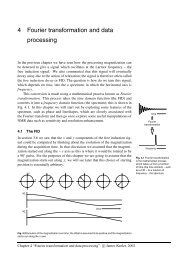Phase Cycling and Gradient Pulses - The James Keeler Group
Phase Cycling and Gradient Pulses - The James Keeler Group
Phase Cycling and Gradient Pulses - The James Keeler Group
Create successful ePaper yourself
Turn your PDF publications into a flip-book with our unique Google optimized e-Paper software.
t 1 t 2<br />
p<br />
2<br />
1<br />
0<br />
–1<br />
–2<br />
∆p=±1 ±1,±3<br />
+1,–3<br />
<strong>The</strong> solid lines under the sequence represent the coherence orders required<br />
during each part of the sequence; note that it is only the pulses which cause a<br />
change in the coherence order. In addition, the values of ∆p are shown for each<br />
pulse. In this example, as is commonly the case, more than one order of<br />
coherence is present at a particular time. Each pulse is required to cause<br />
different changes to the coherence order – for example the second pulse is<br />
required to bring about no less than four values of ∆p. Again, this is a common<br />
feature of pulse sequences.<br />
It is important to realise that the CTP specified with the pulse sequence is<br />
just the desired pathway. We would need to establish separately (for example<br />
using a product operator calculation) that the pulse sequence is indeed capable<br />
of generating the coherences specified in the CTP. Also, the spin system which<br />
we apply the sequence to has to be capable of supporting the coherences. For<br />
example, if there are no couplings, then no double quantum will be generated<br />
<strong>and</strong> thus selection of the above pathway will result in a null spectrum.<br />
<strong>The</strong> coherence transfer pathway must start with p = 0 as this is the order to<br />
which equilibrium magnetization (z-magnetization) belongs. In addition, the<br />
pathway has to end with |p| = 1 as it is only single quantum coherence that is<br />
observable. If we use quadrature detection (section 9.2.2) it turns out that only<br />
one of p = ±1 is observable; we will follow the usual convention of assuming<br />
that p = –1 is the detectable signal.<br />
9.4 Lineshapes <strong>and</strong> frequency discrimination<br />
9.4.1 <strong>Phase</strong> <strong>and</strong> amplitude modulation<br />
–y<br />
<strong>The</strong> selection of a particular CTP has important consequences for lineshapes<br />
t 1 τ m<br />
t 2<br />
<strong>and</strong> frequency discrimination in two-dimensional NMR. <strong>The</strong>se topics are<br />
1<br />
illustrated using the NOESY experiment as an example; the pulse sequence <strong>and</strong> 0<br />
–1<br />
CTP is illustrated opposite.<br />
If we imagine starting with I z<br />
, then at the end of t 1<br />
the operators present are<br />
− cosΩtI<br />
1 y<br />
+ sinΩtI<br />
1 x<br />
<strong>The</strong> term in I y<br />
is rotated onto the z-axis <strong>and</strong> we will assume that only this term<br />
survives. Finally, the z-magnetization is made observable by the last pulse (for<br />
convenience set to phase –y) giving the observable term present at t 2<br />
= 0 as<br />
cosΩt 1<br />
I x<br />
As was noted in section 9.3.1, I x<br />
is in fact a mixture of coherence orders<br />
p = ±1, something which is made evident by writing the operator in terms of I +<br />
9–13


